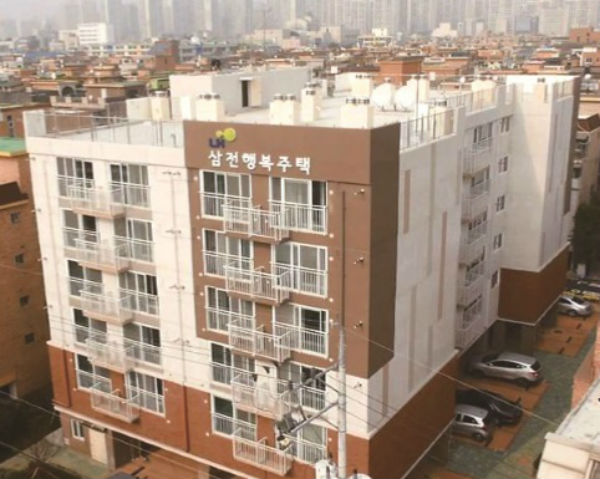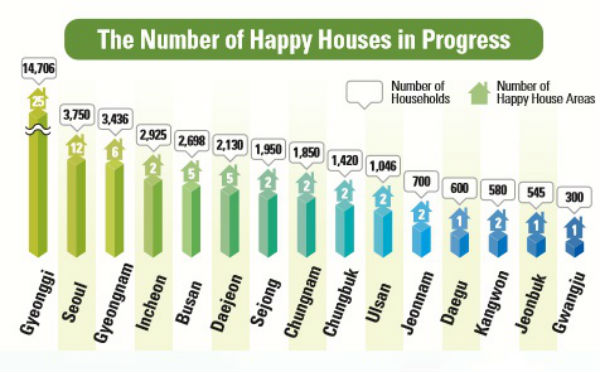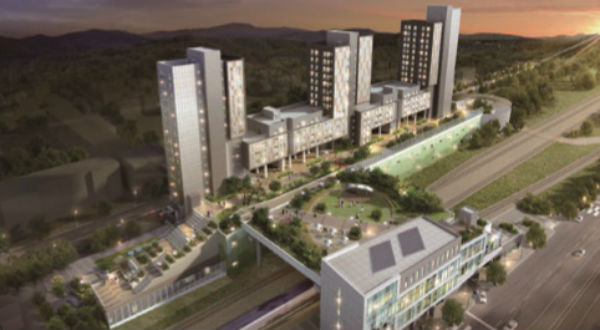Food, clothing, and shelter are commonly said to be the three indispensible factors of life. While all factors can be obtained by paying money, it takes the longest time and the biggest amount of money to own a house. It is even harder for young people who have just taken their first step into society from the starting line. The government has recently come forward to share the burden of youth with the happy housing policy. In hopes of the success of the policy, the Sungkyun Times (SKT) investigates into what happy house is, its expectations, and its concerns.
What Is Happy House?
A Closer Look into Happy House The happy house policy was first introduced by the Park Administration as part of the public rental housing (PRH) policy. It aims to provide homes called “Happy Houses” for young people such as undergraduates and newlyweds at a price that is only 60 to 80 percent of average prices. Happy house differs from other public rental houses in four main points. The first point is purpose. Although both policies are implemented to support those who do not have a full financial capability to buy a house, other PRH is mainly for people with low incomes. The chief aim of happy house, on the other hand, is to supply affordable homes to young people in their 20s and 30s. This leads to the next contrasting point: the candidates. In other subordinate categories of PRH, the candidates should satisfy different conditions for each PRH type. For example, the candidates should have a subscription deposit or meet a certain income standard. The candidates of happy house are undergraduates, newlyweds, and other rookies who satisfy specific conditions written on the next page. In addition, the size of a happy house is smaller than that of PRH because it is built for single or double families. In fact, its size is no bigger than 40㎡.

The last point of differentiation is the location. The areas on which PRH is built were previously limited to development districts in the suburbs. The government lifted this limitation in order to provide PRH at low prices. Happy house is different from other PRH in that it is constructed in downtown areas.
What Called for Happy House?
Distant Dream of House Ownership The average cost of housing in 2015 was 243 million (Korean Appraisal Board). The average income of people from 20 to 34, on the other hand was 32 million per year in 2014 (Ministry of Land, Infrastructure, and Transport). Theoretically, it would take seven years and four months for a young person to own a house based on the premise that he or she does not spend money on anything else and saves all of the income during that time. With even the impossible shortcut of seven years being such a long period, the dream of home ownership seems distant. In reality, many young people have become “rent poor.” That is, they are forced to spend a big portion of their money on renting houses and live on a small amount of money. In fact, undergraduates who live close to their schools apart from their family paid as much as 70 million for Jeonse, a special rental system in Korea, or 30 million for a deposit and 430,000 for monthly rental fees in 2014. After graduation, most of them buy a house with the help of loans. Repaying principles and interest rates of the loan hinders their stepping into society and settling down. Political Indifference Despite the severity of housing problems for youth, they were subject to political indifference until recently. The existing PRH had carried out construction and distribution of homes for families of three or four people. The percentage of residents of different age groups of PRH in Seoul supports the indifference. In 2015, residents in their 20s only accounted for 1.2 percent and in their 30s for 8.5 percent. Happy house was the first policy to specifically address the youth and their problems. The Ministry of Land, Infrastructure, and Transport (MOLIT) announced that they would provide 18,000 happy houses this year and 140,000 by 2017. In Seoul, happy houses are currently being constructed in Gajwa, Oryu, Songpa, and other areas of Seoul. Daegu and Incheon received their first applicants in April. MOLIT announced on April 25 that 23,607 people applied for 1,637 total happy house offers. Happy house in Gajwa was especially popular to people in their 20s as the competition rate for 40 offers of 16㎡ houses supplied for career beginners and undergraduates reached 178.3 to 1. MOLIT added that there will be further openings for 9,000 happy house offers in June, September, and December this year.

Expectations and Concerns
The most noticeable characteristic of the happy housing policy is that it supplies affordable homes to young people. The government hopes that the policy will alleviate the housing problems that young people are facing. In fact, the government allotted 80 percent of the whole supply for the young and the other 20 percent for low income families and the elderly. However, there is a concern over this as well. The stigma effect has been a grave problem for PRH, and some people worry that happy house will not be an exception. There is a social prejudice that PRH is the poor’s residential area. The recently coined term “Hu-geo” reflects this phenomenon. Hugeo is a combination of “Humansia” and “Geoji.” The former is an apartment brand of the Korea Land and Housing Corporation (LH), which is an affiliated company of MOLIT and constructs PRH apartments. The latter is a Korean word for a beggar. Together, it means “the beggar who lives in PRH.” The term spread quickly among elementary school students as a means of bullying innocent students of the same age for being poor and living in PRH.
The beginning of the bullying and discrimination was due to Seoul City’s implementation of the “Social Mix Policy,” and it has become more blatant in the last two years. The policy mixed PRH and other apartments in the same housing complex in order to diminish the conflicts between residents of different financial statuses. The result, however, was the opposite. In 2014, reports of an apartment complex that forbade children of PRH apartments from using the shared playground located in the complex rose to the surface. In 2015, one elementary school made students stand in two lines: an ordinary one, and another for Hu-geo. Many people blame parents and adults for these attitudes in children. Therefore, the kind of image happy houses would deliver to the public is a critical issue so as to fully bring out its good intention. Another characteristic of happy house is that it is built on government-owned lands in the city. These government-owned lands in the city are mostly those near railroads. In the national aspect, the government can make efficient use of vacant land. In the residents’ aspect, living in a station area means easier commuting. For example, happy houses in Gajwa, of which construction is to be completed in December, will provide enormous convenience to students of Yonsei, Ewha, Hongik, and other nearby universities. In addition, using public transportations instead of cars is not only environment-friendly, but also economic.

The downside to this is the high possibility of noise pollution. Happy house in Gajwa, which is said to be equipped with the most ideal conditions for happy house, is located right next to the Gyeongui Line. The Gyeongui Line is a little different from other subway lines in that it runs overground as well as underground. Thus, the noise coming from the subway is directly released into the open air. Considering that the Gyeongui Line passes Gajwa Station more than 400 times per day, concerns related to noise pollution have arisen. MOLIT reassured them and announced that the construction began after it conducted simulation on noise predictions and confirmed that they qualify for every criterion on housing construction standards with respect to noise. The remaining two questions, however, are whether the simulation was accurate enough and whether they considered nocturnal noises as well. Although the problem sounds complex, there are preceding examples of happy houses in Japan and France where residents live by train stations and yet do not suffer from noise pollution. In other words, with careful attention and responsibility during the process of construction, the problems related to noise can be successfully solved. Besides providing a place to live, happy house serves various functions to enhance the overall living standards of its residents. Six government departments have collaborated to achieve this goal. For example, plans for public nursery facilities by the Ministry of Health and Welfare, employment centers by the Ministry of Employment and Labor, and local food stores by the Ministry of Agriculture, Food, and Rural Affairs are being carried out. These facilities, which will be located within the happy house complex, are expected to promote the local economy as well. In fact, specific discussions on how to boost the economy have proceeded. One of the methods is giving incentives to commercial facilities when they employ residents. However, the residents of the area have expressed worries that the emergence of such a cultural and economic center would result in heavy traffic and problems following excessively crowded populations. Another controversy that has risen to the surface is whether the government is encouraging single households. Happy houses are designed for a single person. The small dimensions can accommodate two people at most. There is another kind of PRH that is designed for single households: those provided to elderly who live alone. For a majority of them, living alone is another word for solitude. Depression makes them suffer and can lead to death at times. Even when they die, they often go unnoticed for weeks. Indeed, the situation is different for the elderly and the young in that the latter spend most of the day outside with others. It is true, however, that single households feel loneliness more than those who live in a family. Thus, some people say that it is not what the government should encourage at the national level.
Although a good result requires a good intention, a good intention itself is not the only prerequisite for a good result. The intention of the happy housing policy could not be better for the young people in Korea. Therefore, the government should carefully monitor its process to fulfill the ambitious goal with which it started.
